Data Augmentation of Automotive LIDAR Point Clouds under Adverse Weather Situations
Abstract
:1. Introduction
State of the Art
2. Experiment
2.1. Region of Insterest
2.2. Measurement
2.3. Simulation
- Simulating real water drops as well as the exact forces that act upon them cannot be done in real time. However, the number of detections that those drops cause is usually much smaller as a high concentration of drops is needed to cause a reflection strong enough to cause a detection. Therefore, a more efficient approach is to use particles to directly simulate detections instead of single drops.
- The solver used by Blender [33] to calculate the trajectories of the particles is stable in the required parameter range.
- The LIDAR sensor itself can be simulated in the same way as a camera image is rendered by adapting the calculation done inside the material shader. The calculation is changed from the default multiplication of intensities to an addition of ray distances. One color channel is left unchanged; as a result, each camera pixel contains the information about the distance that the ray traveled from the light source and its corresponding intensity. The light source is placed next to the camera and both camera and light source are configured based on the resolution and field of view of the sensor.
- If physically based values are used for the materials, as shown inside the dashed line region of Figure 4, the calculated intensities per pixel should be proportional to the ones obtained using the real sensor.
- For each frame, the radial histogram per layer is calculated.
- The bins that contain detections caused by the box are extracted.
- The detections inside the bins are organized in ascending order based on their radial distance from the sensor.
- The first detection is used and the rest are removed. The detections in the region from 0 to 5 m are not taken into consideration as their effect was already included when generating the synthetic data.
3. Results
- Small features: 10 cm in ‘x’ by 10 cm in ‘y’.
- Vehicle rear: 20 cm in ‘x’ by 2 m in ‘y’.
- Vehicle side: 4 m in ‘x’ by 10 cm in ‘y’.
- Middle size features: 50 cm in ‘x’ by 50 cm in ‘y’.
- Radial: 1°.
- X position.
- Y position.
- Echo number.
- Layer number.
- EPW value.
- Number of counts (radial).
- Number of counts (small features).
- Number of counts (vehicle rear).
- Number of counts (vehicle side).
- Number of counts (middle size feature).
- Absolute value of the subtraction of parameter six of the current frame from parameter six of previous frame.
- Convolution with horizontal matrix (Appendix B) (small features).
- Convolution with corner matrix1 (small features).
- Convolution with corner matrix1 rotated 90° (small features).
- Convolution with impulse matrix1 (small features).
4. Discussion
5. Conclusions
Author Contributions
Funding
Institutional Review Board Statement
Informed Consent Statement
Data Availability Statement
Conflicts of Interest
Abbreviations
| ADAS | Advanced driver assistance systems. |
| AV | Autonomous vehicles. |
| EPW | Echo pulse width. |
| GPS | Global positioning system. |
| IOR | Index of refraction. |
| LIDAR | Light detection and ranging. |
| LV | Leading vehicle. |
| OI | Object index. |
| ROI | Region of interest. |
Appendix A

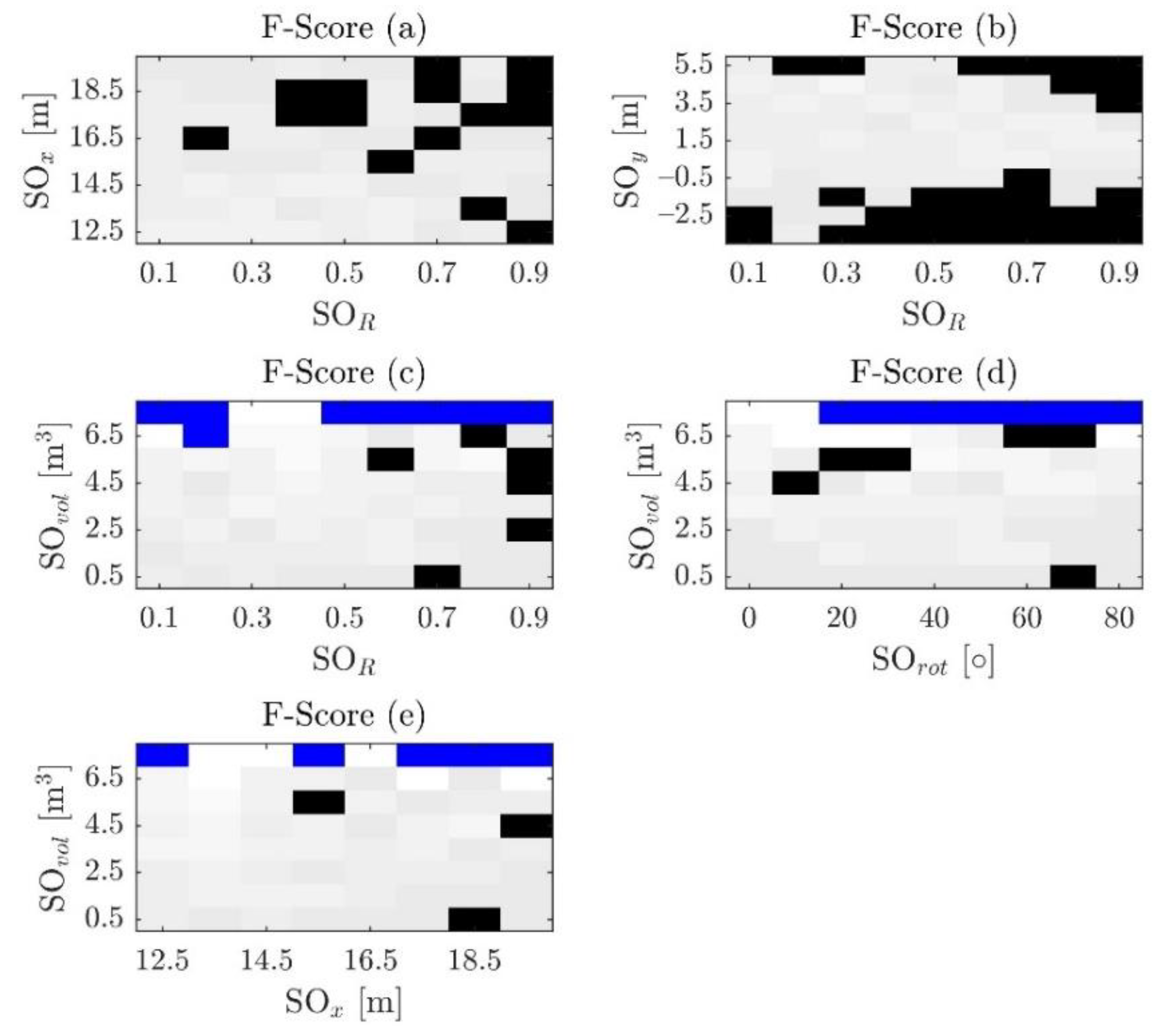
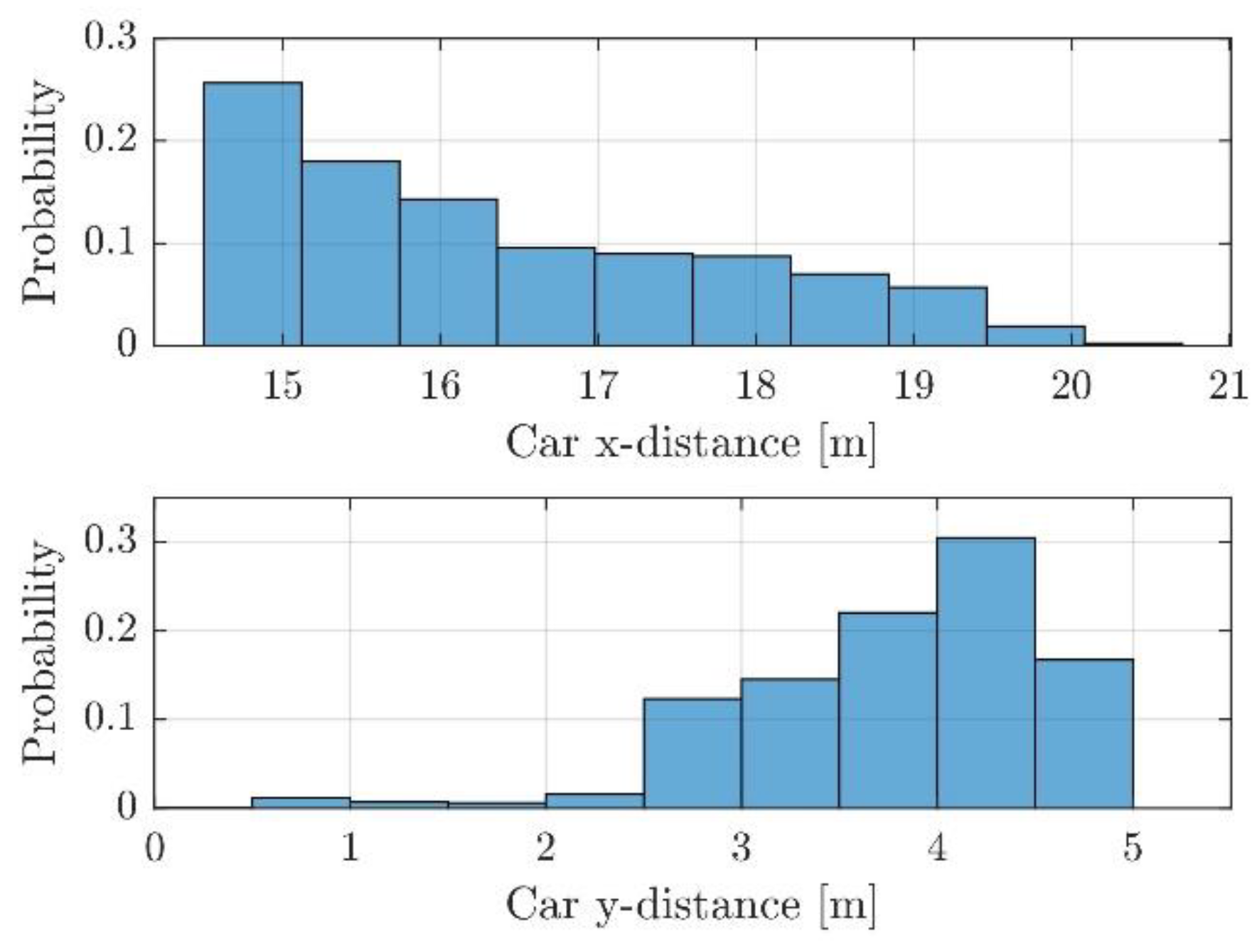
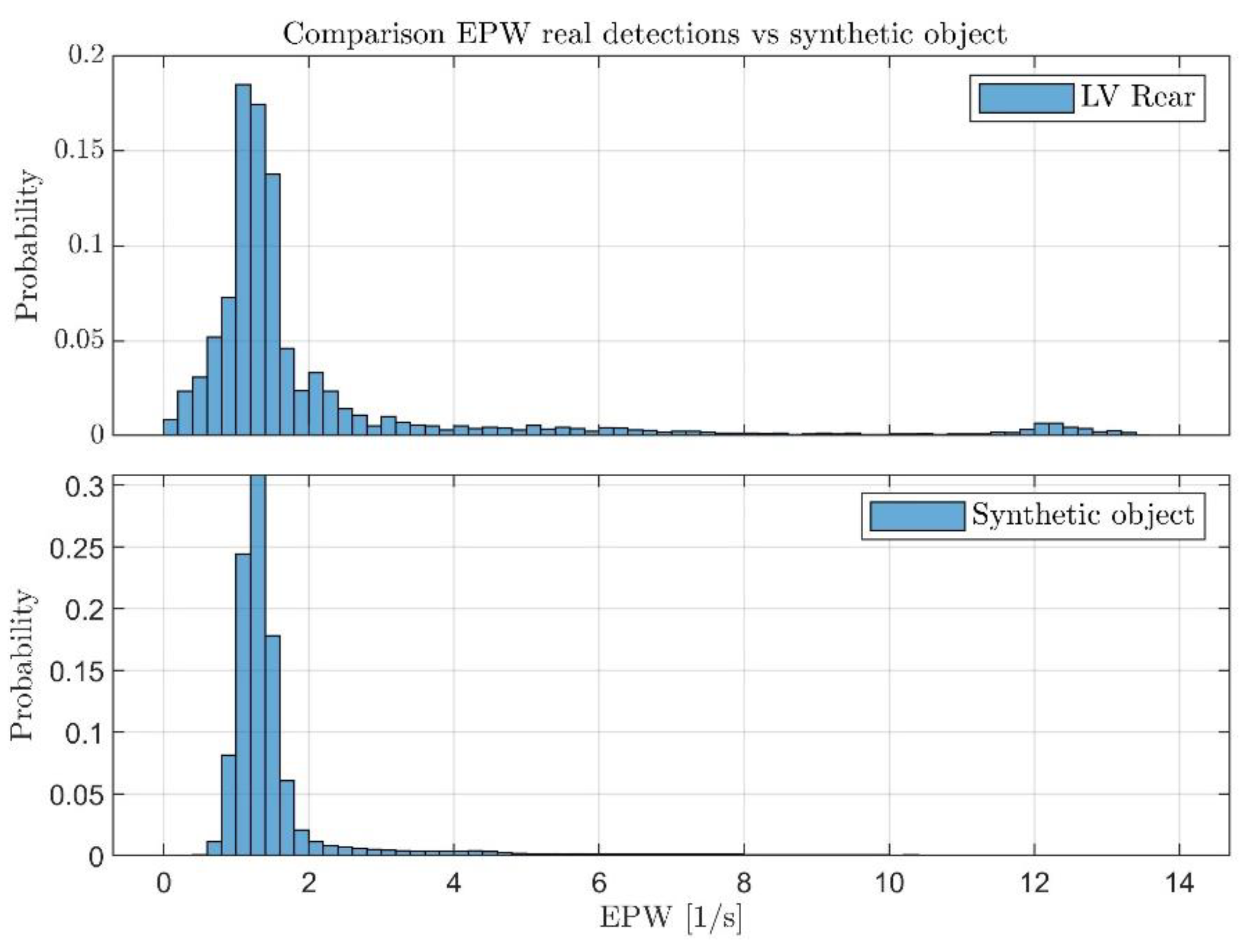
Appendix B
References
- Kocić, J.; Jovičić, N.; Drndarević, V. Sensors and sensor fusion in autonomous vehicles. In Proceedings of the 2018 26th Telecommunications Forum (TELFOR), Belgrade, Serbia, 20–21 November 2018; pp. 420–425. [Google Scholar]
- Kim, J.; Han, D.S.; Senouci, B. Radar and vision sensor fusion for object detection in autonomous vehicle surroundings. In Proceedings of the 2018 Tenth International Conference on Ubiquitous and Future Networks (ICUFN), Prague, Czech, 3–6 July 2018; pp. 76–78. [Google Scholar]
- Wang, Z.; Wu, Y.; Niu, Q. Multi-sensor fusion in automated driving: A survey. IEEE Access 2019, 8, 2847–2868. [Google Scholar] [CrossRef]
- Göhring, D.; Wang, M.; Schnürmacher, M.; Ganjineh, T. Radar/lidar sensor fusion for car-following on highways. In Proceedings of the 5th International Conference on Automation, Robotics and Applications, Wellington, New Zealand, 6–8 December 2011; pp. 407–412. [Google Scholar]
- Verucchi, M.; Bartoli, L.; Bagni, F.; Gatti, F.; Burgio, P.; Bertogna, M. Real-Time clustering and LiDAR-camera fusion on embedded platforms for self-driving cars. In Proceedings of the 2020 Fourth IEEE International Conference on Robotic Computing (IRC), Taichung, Taiwan, 9–11 November 2020; pp. 398–405. [Google Scholar]
- Rivero, J.R.V.; Tahiraj, I.; Schubert, O.; Glassl, C.; Buschardt, B.; Berk, M.; Chen, J. Characterization and simulation of the effect of road dirt on the performance of a laser scanner. In Proceedings of the 2017 IEEE 20th International Conference on Intelligent Transportation Systems (ITSC), Yokohama, Japan, 16–19 October 2017; pp. 1–6. [Google Scholar]
- Heinzler, R.; Schindler, P.; Seekircher, J.; Ritter, W.; Stork, W. Weather influence and classification with automotive lidar sensors. In Proceedings of the 2019 IEEE Intelligent Vehicles Symposium (IV), Paris, France, 9–12 June 2019; pp. 1527–1534. [Google Scholar]
- Vargas Rivero, J.R.; Gerbich, T.; Teiluf, V.; Buschardt, B.; Chen, J. Weather Classification Using an Automotive LIDAR Sensor Based on Detections on Asphalt and Atmosphere. Sensors 2020, 20, 4306. [Google Scholar] [CrossRef]
- Hasirlioglu, S.; Riener, A.; Huber, W.; Wintersberger, P. Effects of exhaust gases on laser scanner data quality at low ambient temperatures. In Proceedings of the 2017 IEEE Intelligent Vehicles Symposium (IV), Los Angeles, CA, USA, 11–14 June 2017; pp. 1708–1713. [Google Scholar]
- Vargas Rivero, J.R.; Gerbich, T.; Buschardt, B.; Chen, J. The Effect of Spray Water on an Automotive LIDAR Sensor: A Real-Time Simulation Study. IEEE Trans. Intell. Veh. 2021. [Google Scholar] [CrossRef]
- Yang, B.; Luo, W.; Urtasun, R. Pixor: Real-time 3D object detection from point clouds. In Proceedings of the IEEE Conference on Computer Vision and Pattern Recognition, Salt Lake City, UT, USA, 18–23 June 2018; pp. 7652–7660. [Google Scholar]
- Yan, Y.; Mao, Y.; Li, B. Second: Sparsely embedded convolutional detection. Sensors 2018, 18, 3337. [Google Scholar] [CrossRef] [PubMed] [Green Version]
- Zhou, Y.; Tuzel, O. Voxelnet: End-to-end learning for point cloud based 3D object detection. In Proceedings of the IEEE Conference on Computer Vision and Pattern Recognition, Salt Lake City, UT, USA, 18–23 June 2018; pp. 4490–4499. [Google Scholar]
- Hahner, M.; Dai, D.; Liniger, A.; van Gool, L. Quantifying Data Augmentation for LiDAR based 3D Object Detection. arXiv 2020, arXiv:2004.01643. [Google Scholar]
- Li, R.; Li, X.; Heng, P.-A.; Fu, C.-W. PointAugment: An Auto-Augmentation Framework for Point Cloud Classification. In Proceedings of the IEEE/CVF Conference on Computer Vision and Pattern Recognition, Seattle, WA, USA, 13–19 June 2020; pp. 6378–6387. [Google Scholar]
- Cheng, S.; Leng, Z.; Cubuk, E.D.; Zoph, B.; Bai, C.; Ngiam, J.; Song, Y.; Caine, B.; Vasudevan, V.; Li, C.; et al. Improving 3D Object Detection through Progressive Population Based Augmentation; Springer: Cham, Germany, 2020. [Google Scholar]
- Fang, J.; Zhou, D.; Yan, F.; Zhao, T.; Zhang, F.; Ma, Y.; Wang, L.; Yang, R. Augmented LiDAR Simulator for Autonomous Driving. IEEE Robot. Autom. Lett. 2020, 5, 1930–1937. [Google Scholar] [CrossRef] [Green Version]
- Tu, J.; Ren, M.; Manivasagam, S.; Liang, M.; Yang, B.; Du, R.; Cheng, F.; Urtasun, R. Physically Realizable Adversarial Examples for LiDAR Object Detection. In Proceedings of the IEEE/CVF Conference on Computer Vision and Pattern Recognition (CVPR), Seattle, WA, USA, 13–19 June 2020. [Google Scholar]
- Yue, X.; Wu, B.; Seshia, S.A.; Keutzer, K.; Sangiovanni-Vincentelli, A.L. A lidar point cloud generator: From a virtual world to autonomous driving. In Proceedings of the 2018 ACM on International Conference on Multimedia Retrieval, Yokohama, Japan, 11–14 June 2018; pp. 458–464. [Google Scholar]
- Feng, Y.; Liu, H.X. Augmented reality for robocars. IEEE Spectr. 2019, 56, 22–27. [Google Scholar] [CrossRef]
- Dosovitskiy, A.; Ros, G.; Codevilla, F.; Lopez, A.; Koltun, V. CARLA: An open urban driving simulator. arXiv 2017, arXiv:1711.03938. [Google Scholar]
- Johnson-Roberson, M.; Barto, C.; Mehta, R.; Sridhar, S.N.; Rosaen, K.; Vasudevan, R. Driving in the matrix: Can virtual worlds replace human-generated annotations for real world tasks? arXiv 2016, arXiv:1610.01983. [Google Scholar]
- Griffiths, D.; Boehm, J. SynthCity: A large scale synthetic point cloud. arXiv 2019, arXiv:1907.04758. [Google Scholar]
- Wu, B.; Wan, A.; Yue, X.; Keutzer, K. Squeezeseg: Convolutional neural nets with recurrent crf for real-time road-object segmentation from 3d lidar point cloud. In Proceedings of the 2018 IEEE International Conference on Robotics and Automation (ICRA), Brisbane, QLD, Australia, 21–25 May 2018; pp. 1887–1893. [Google Scholar]
- Wu, B.; Zhou, X.; Zhao, S.; Yue, X.; Keutzer, K. Squeezesegv2: Improved model structure and unsupervised domain adaptation for road-object segmentation from a lidar point cloud. In Proceedings of the 2019 International Conference on Robotics and Automation (ICRA), Montreal, QC, Canada, 20–24 May 2019; pp. 4376–4382. [Google Scholar]
- Zhao, S.; Wang, Y.; Li, B.; Wu, B.; Gao, Y.; Xu, P.; Darrell, T.; Keutzer, K. ePointDA: An End-to-End Simulation-to-Real Domain Adaptation Framework for LiDAR Point Cloud Segmentation. arXiv 2020, arXiv:2009.03456. [Google Scholar]
- Blender Project. Cycles: Open Source Production Rendering. Available online: https://www.cycles-renderer.org/ (accessed on 10 January 2021).
- Yu, S.-L.; Westfechtel, T.; Hamada, R.; Ohno, K.; Tadokoro, S. Vehicle detection and localization on bird’s eye view elevation images using convolutional neural network. In Proceedings of the 2017 IEEE International Symposium on Safety, Security and Rescue Robotics (SSRR), Shanghai, China, 11–13 October 2017; pp. 102–109. [Google Scholar]
- Mohapatra, S.; Yogamani, S.; Gotzig, H.; Milz, S.; Mader, P. BEVDetNet: Bird’s Eye View LiDAR Point Cloud based Real-time 3D Object Detection for Autonomous Driving. arXiv 2021, arXiv:2104.10780. [Google Scholar]
- Skutek, M. Ein PreCrash-System auf Basis Multisensorieller Umgebungserfassung; Shaker: Düren, Germany, 2006. [Google Scholar]
- Wu, H.; Hou, H.; Shen, M.; Yang, K.H.; Jin, X. Occupant kinematics and biomechanics during frontal collision in autonomous vehicles—can rotatable seat provides additional protection? Comput. Methods Biomech. Biomed. Eng. 2020, 23, 191–200. [Google Scholar] [CrossRef]
- RISER Consortium. Roadside Infrastructure for Safer European Roads. Available online: https://ec.europa.eu/transport/road_safety/sites/roadsafety/files/pdf/projects_sources/riser_guidelines_for_roadside_infrastructure_on_new_and_existing_roads.pdf (accessed on 29 June 2021).
- Blender Online Community. Blender—A 3D Modelling and Rendering Package. Available online: https://www.blender.org/ (accessed on 29 June 2021).
- Blender 2.91 Manual. Rendering/Layers and Passes/Passes. Available online: https://docs.blender.org/manual/en/latest/render/layers/passes.html (accessed on 9 January 2021).
- Liu, S.; Tang, J.; Zhang, Z.; Gaudiot, J.-L. Computer Architectures for Autonomous Driving. Computer 2017, 50, 18–25. [Google Scholar] [CrossRef]
- Alcaide, S.; Kosmidis, L.; Hernandez, C.; Abella, J. Software-only Diverse Redundancy on GPUs for Autonomous Driving Platforms. In Proceedings of the 2019 IEEE 25th International Symposium on On-Line Testing and Robust System Design (IOLTS), Rhodes, Greece, 1–3 July 2019; pp. 90–96. [Google Scholar]
- Zeisler, J.; Maas, H.-G. Analysis of the performance of a laser scanner for predictive automotive applications. ISPRS Ann. Photogramm. Remote Sens. Spat. Inf. Sci. 2015, 2, 49–56. [Google Scholar] [CrossRef] [Green Version]
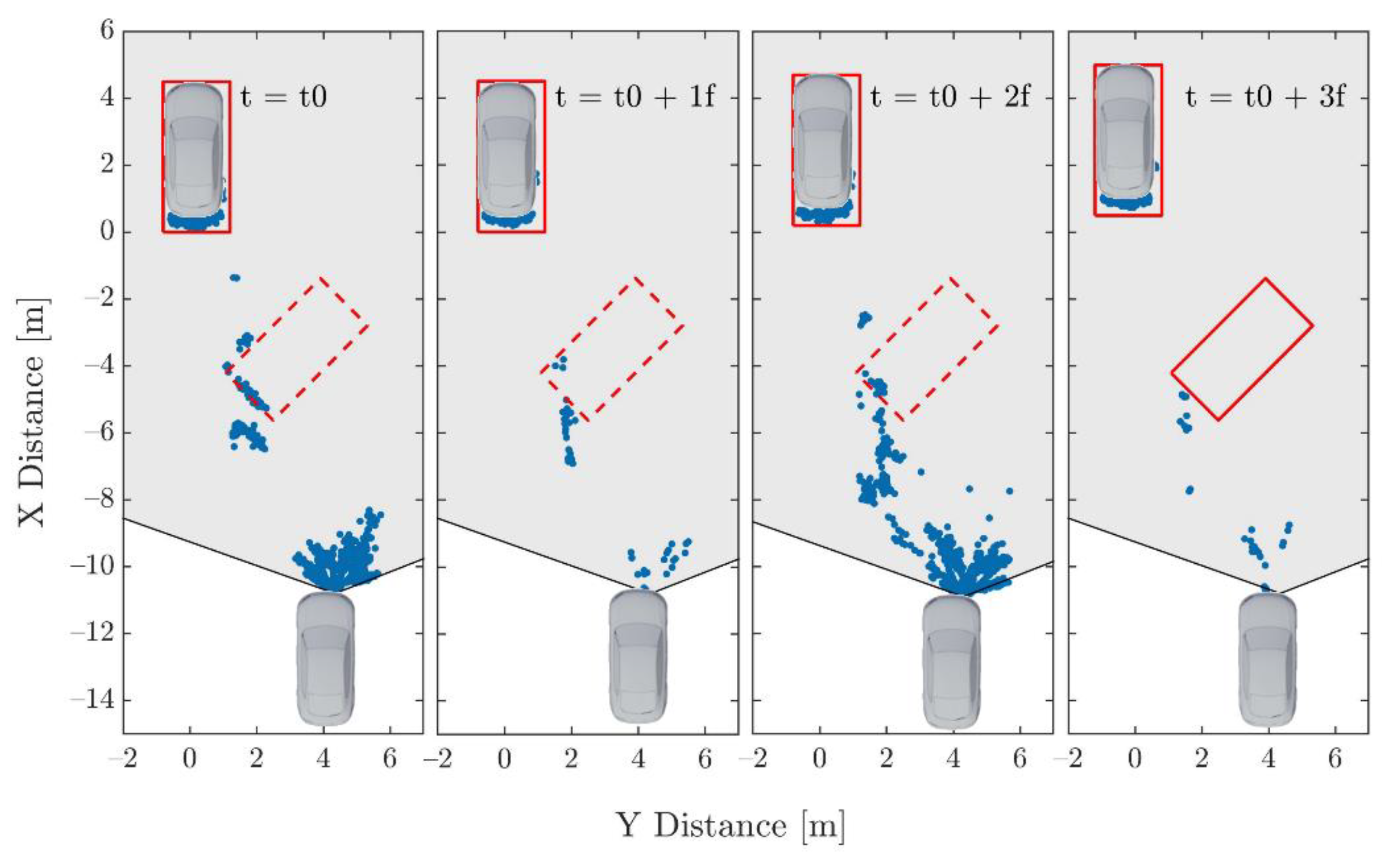

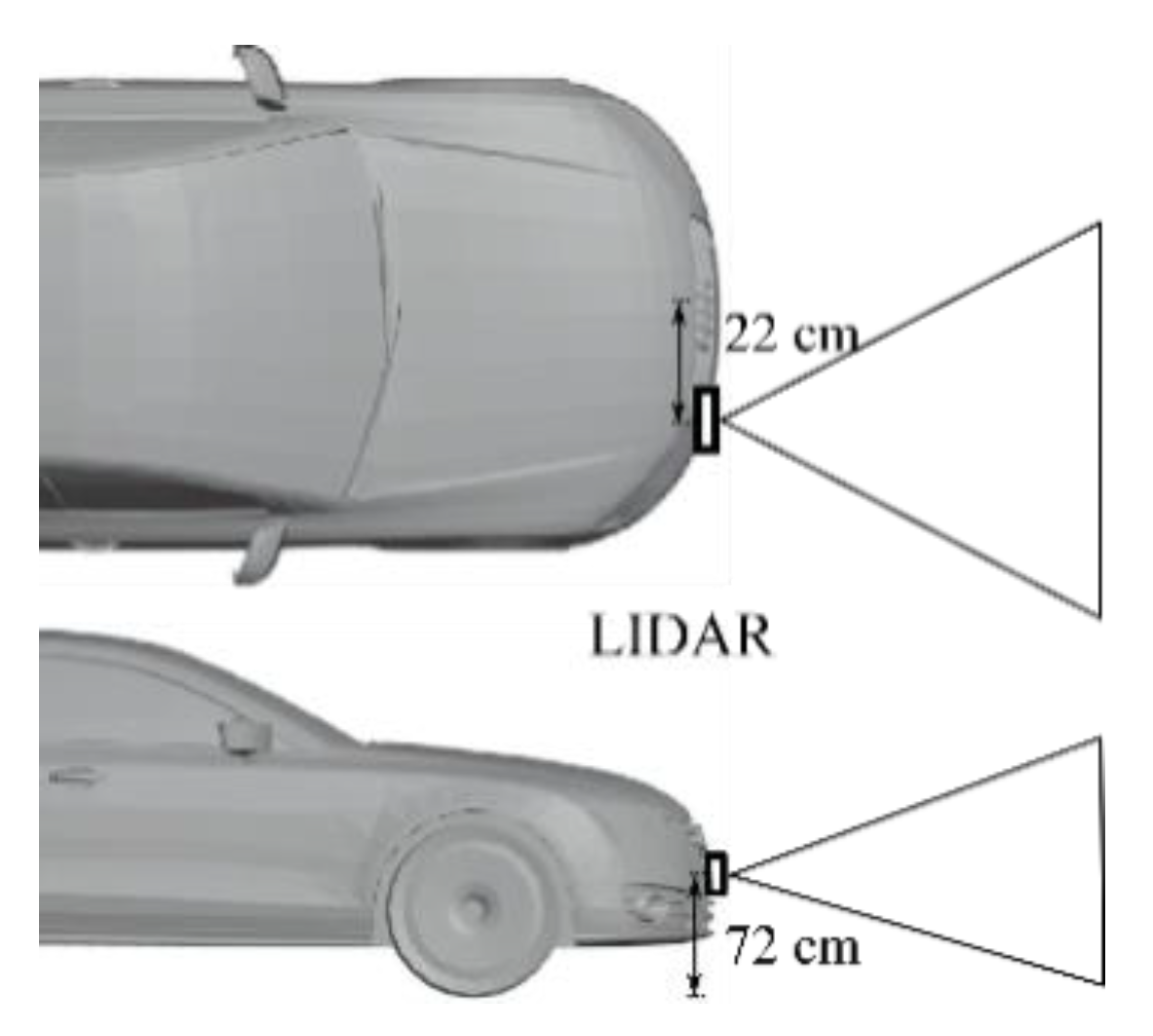
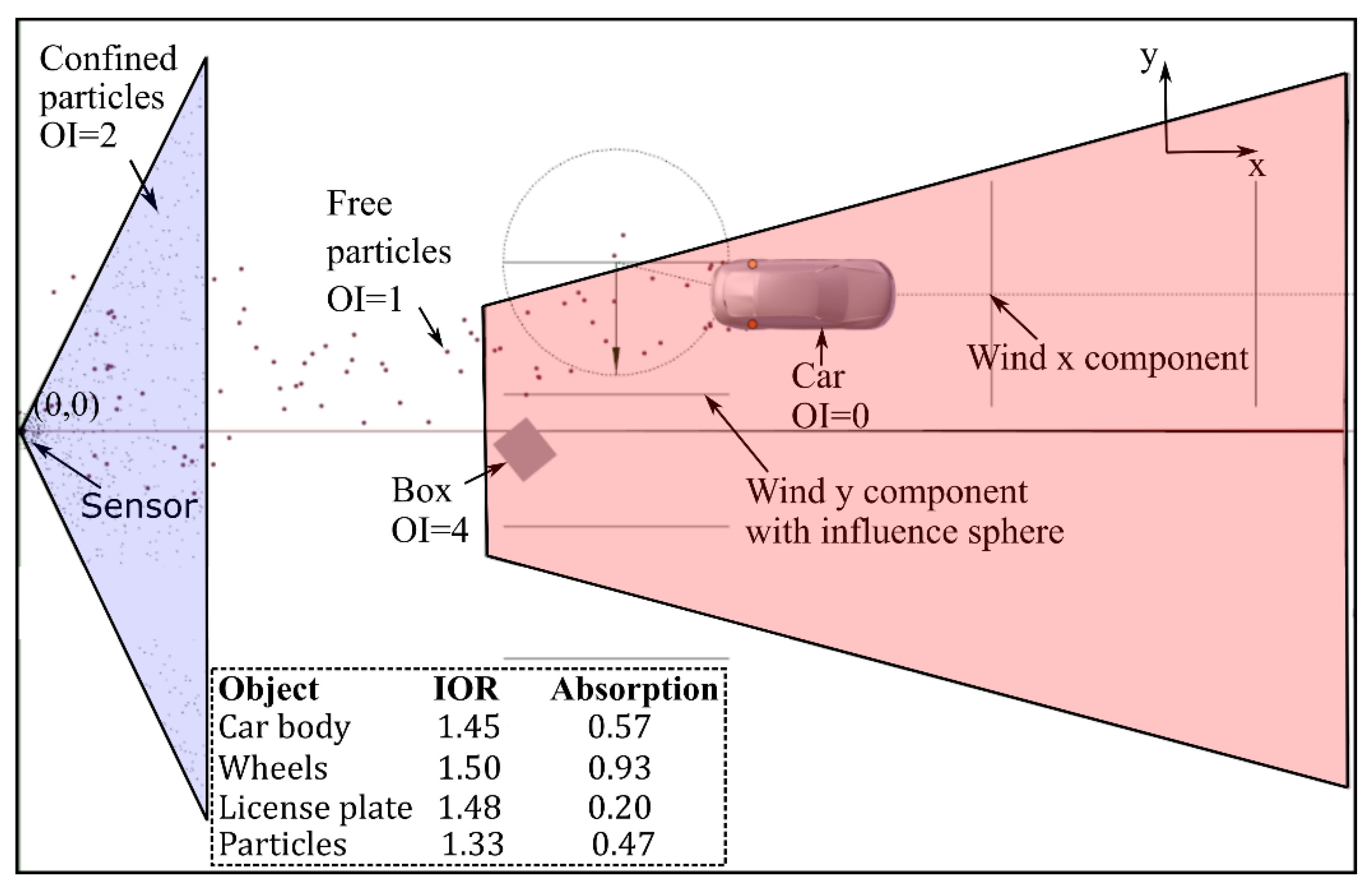
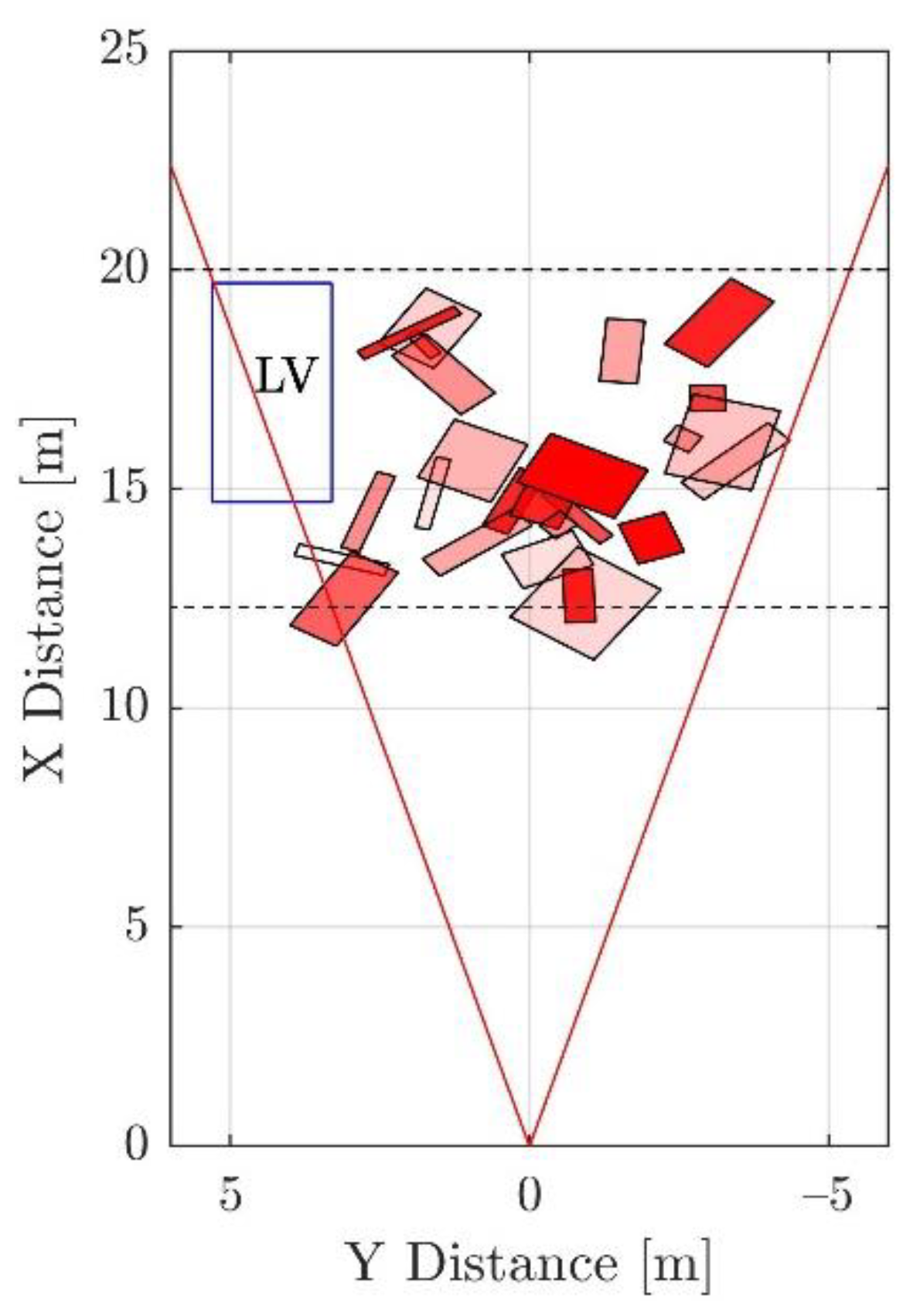

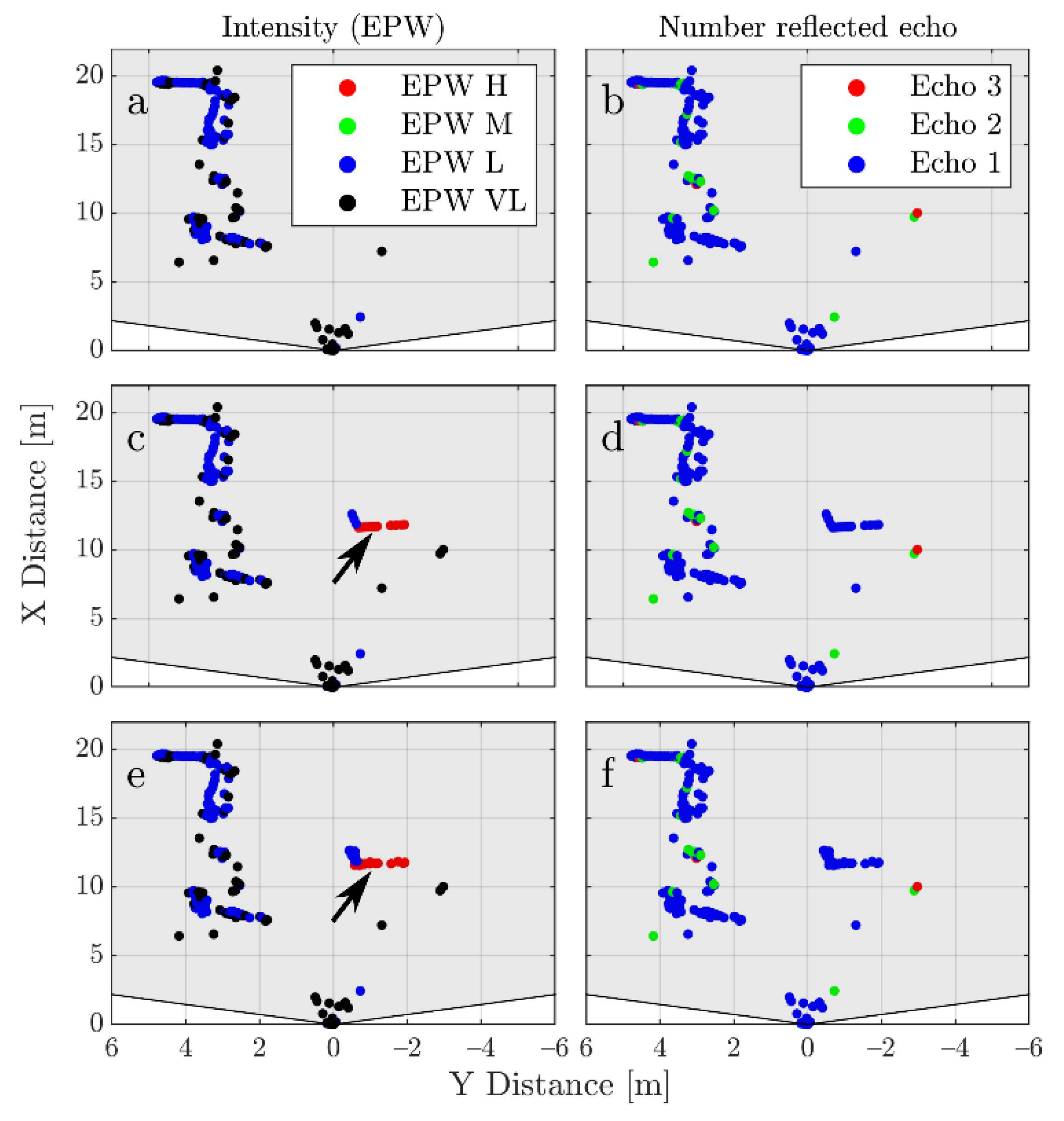
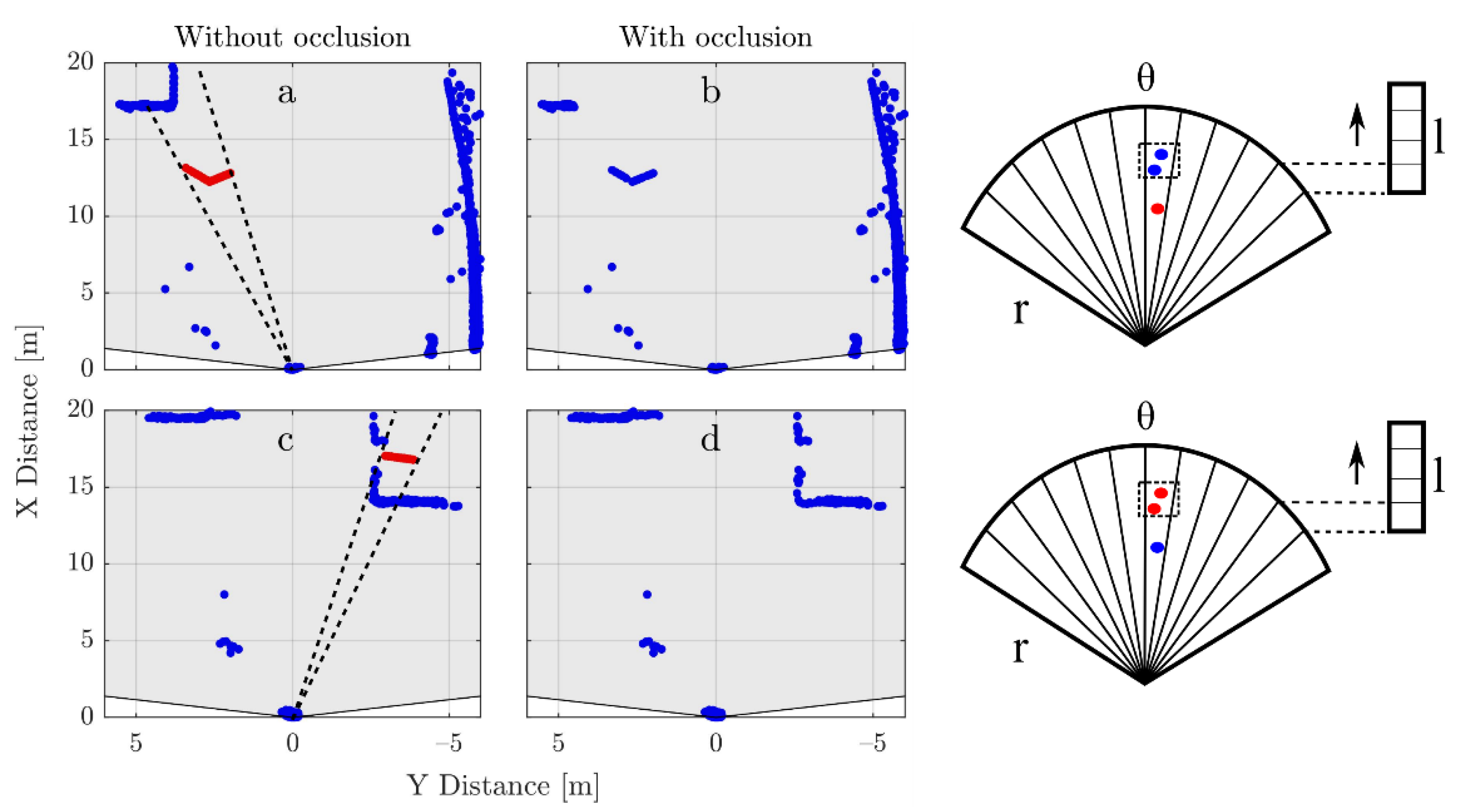
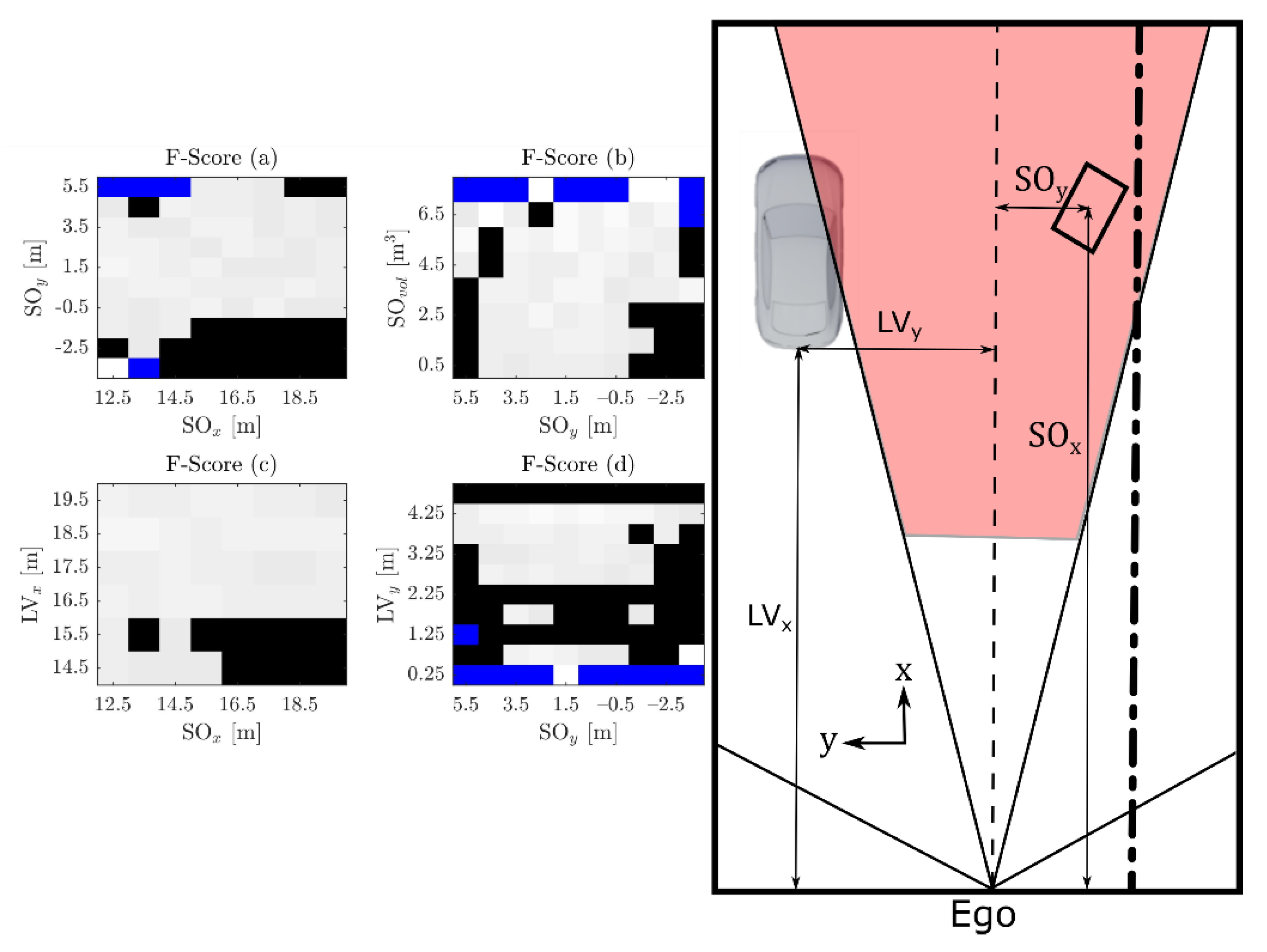
| Date | Duration | Rainfall |
|---|---|---|
| 13 April 2018 | 1 h 17 min | 2 mm |
| 16 May 2018 | 3 h 26 min | 3.6 mm |
| 17 May 2018 | 2 h 20 min | 3.1 mm |
| Particles | Number of Particles | Distribution | Mesh Diameter |
|---|---|---|---|
| Free | ~50 per wheel per frame | Defined by acting forces | 1.8 cm |
| Confined | 200.000 | Uniformly | 6 mm |
| Predicted Class | |||||
|---|---|---|---|---|---|
| All Durations | Duration 3f | ||||
| NB | B | NB | B | ||
| Actual class | NB | 12,454,236 | 20,036 | 4,150,856 | 6686 |
| B | 3848 | 141,545 | 1178 | 47,055 | |
| F-Score | 99.90 | 92.22 | 99.91 | 92.29 | |
Publisher’s Note: MDPI stays neutral with regard to jurisdictional claims in published maps and institutional affiliations. |
© 2021 by the authors. Licensee MDPI, Basel, Switzerland. This article is an open access article distributed under the terms and conditions of the Creative Commons Attribution (CC BY) license (https://creativecommons.org/licenses/by/4.0/).
Share and Cite
Vargas Rivero, J.R.; Gerbich, T.; Buschardt, B.; Chen, J. Data Augmentation of Automotive LIDAR Point Clouds under Adverse Weather Situations. Sensors 2021, 21, 4503. https://doi.org/10.3390/s21134503
Vargas Rivero JR, Gerbich T, Buschardt B, Chen J. Data Augmentation of Automotive LIDAR Point Clouds under Adverse Weather Situations. Sensors. 2021; 21(13):4503. https://doi.org/10.3390/s21134503
Chicago/Turabian StyleVargas Rivero, Jose Roberto, Thiemo Gerbich, Boris Buschardt, and Jia Chen. 2021. "Data Augmentation of Automotive LIDAR Point Clouds under Adverse Weather Situations" Sensors 21, no. 13: 4503. https://doi.org/10.3390/s21134503
APA StyleVargas Rivero, J. R., Gerbich, T., Buschardt, B., & Chen, J. (2021). Data Augmentation of Automotive LIDAR Point Clouds under Adverse Weather Situations. Sensors, 21(13), 4503. https://doi.org/10.3390/s21134503






